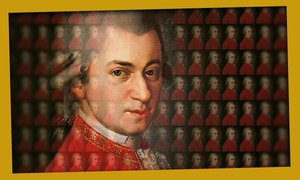Grand Hall
Mozart: Ch'io mi scordi di te, K. 505
Mozart: E-flat major piano concerto, K. 482
Mozart: Ah, chi mi dice mai (aria from Don Giovanni)
Mozart: Porgi, amor, qualche ristoro (aria from The Marriage of Figaro)
Mozart: Ah! Fuggi il traditor (aria from Don Giovanni)
Mozart: Symphony No.41 in C major, "Jupiter", K. 551
Featuring: Andrea Rost, Gergely Bogányi
Concerto Budapest
Conducting: András Keller

Wolfgang Amadeus Mozart: Arias
“Scene and rondo, with piano solo; for Madame Storace and me”. Mozart already set the libretto (“Ch’io mi scordi di te – Non temer amato bene”) to music in Idomeneo, in the love scene of Ilia and Idamentes in act 3. Some presume that this repeated setting to music served as a personal message. London-born singer Anna Storace arrived in Vienna from Italy in 1783. The celebrated, brilliantly talented artist was the first Suzanna of Mozart’s Figaro. She left Vienna in 1787, and at the concert bidding her farewell this aria was performed, with the personal involvement of Mozart. The libretto refers to this “farewell situation”: “That I would ever forget you?!” ask Idamentes passionately in the recitativo. “Don’t fear, my dear love, my heart stays with you forever” is the response.
Donna Elvira is without question the most interesting, complex female character in Don Giovanni. The near unhealthily relationship-dependent figure, who at the same time harbours deep feelings, is truth abiding and perhaps overly generous in her forgiveness, is placed by Mozart and Da Ponte into the most varied of situations, that is, aria situations. We meet the dreamy character able to rise above her grievances in the magnificent aria beginning “Ah, chi mi dice mai”, we hear her decisive (she is protecting Zerlina’s innocence) voice that brooks no contradiction in the brief “Ah! Fuggi il traditor” aria. Mozart’s arias often produce the sense that they are pinpoint accurate psychological analyses. In this regard, too, the Countess’s melancholic, resigned cavatina (although still ardent with emotions) is a true gem in The Marriage of Figaro (“Porgi, amor, qualche ristoro”). Géza Fodor noted that this aria “… is all about the insoluble problem of the life of the Countess.”
Wolfgang Amadeus Mozart: Piano Concerto in E-flat major, K 482
The Piano Concerto in E-flat major (late 1785) was written in parallel with The Marriage of Figaro. At its premiere, it proved at least as successful as the opera. The audience demanded an encore of the second movement in C minor: who knows, perhaps the veiled melancholy of this movement reminded them of the figure of the Countess.
Wolfgang Amadeus Mozart: Symphony in C major (‘Jupiter’), K 551
Mozart’s last three symphonies (1788) were described as “the brightest stars in the musical firmament” even in the 19th century. Among these, the C major symphony impressed not only the general public but fellow musicians. The finale shaped with virtuoso contrapuntal technique is the symphony’s particularly frequently cited movement. ‘Symphony with closing fugue’; this description common in Romanticism also drew attention to this particular movement. The theme beginning with four notes is Mozart’s popular and frequently processed motif, and identical to the start of a Gregorian Magnificat melody. The principal theme appears several times in works for the church written in Salzburg between 1774 and 1776. This subject is already easily adapted to the requirements of the contrapuntal composition. However, Mozart also develops the movement’s further material (according to the sonata form, the transition theme, the second subject and codetta) with the contrapuntal technique. As the highpoint of this masterful weave, the four themes are heard at the same time in the coda of the movement. It is generally considered that London-resident German impresario Johann Peter Salomon, who commissioned Haydn’s ‘London’ symphonies, came up with the name ‘Jupiter symphony’.
